Rigid-flex PCB
What is a Rigid Flexible PCB?
Rigid-flex PCB is a special circuit board made by pressing a rigid circuit board (PCB) and a flexible circuit board (FCB). The rigid pcb part usually choose fr4 material and the flex pcb part is polyimide. The flex-rigid board combines the advantages of the rigid characteristics of rigid PCB and the flexible characteristics of flexible PCB, so that the PCB is no longer in two-dimensional space, but is folded by three-dimensional internal wiring and arbitrary bending. In this way, the rigid-flex board can realize complex circuit layout in a small space. And it has the characteristics of light weight and small size, which is suitable for some fine electronic products.
View more PCB substrate classifications and standards;
Sometimes in order to enhance the firmness and stability of the flexible circuit, designers will arrange ribs on the flexible board. Of course, there are pros and cons. Flexible circuits with stiffeners are limited in where components can be placed and ultimately the overall component density.
The deciding factor in choosing a rigid-flex PCB is the component density of the circuit. As component densities increase, flexible circuits with stiffeners reach their limits and require rigid boards to help solve the problem. Rigid-flex PCB simplifies the assembly process, offering the best of both worlds for flexible design, higher density of components and circuit routing.
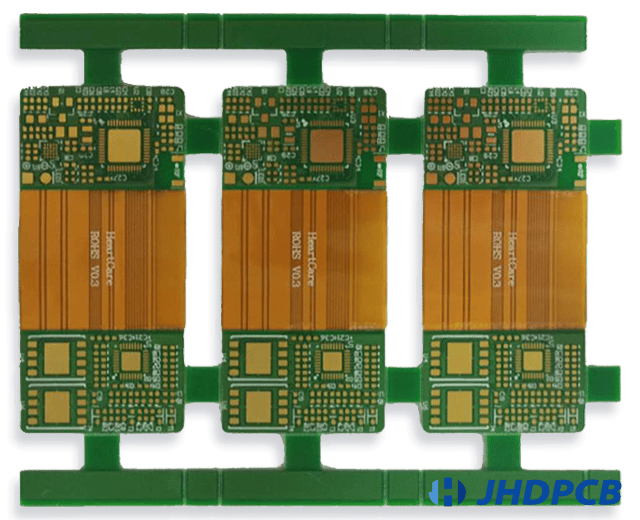
Why Choose Rigid-flexible PCB?
Rigid-flex PCBs are not cheap, why use rigid-flex boards? In pcb design, the cost is often not the key factor.
1. The reliability of the installation of the flexible and rigid board is high:
Usually, FPC is connected through connectors, which brings high installation cost, inconvenient installation, installation reliability problems, and risks such as easy short circuits and falling off. Rigid Flexible PCB do not require connectors to connect, so they can solve these problems well.
2. The comprehensive cost of the rigid flex board is lower:
Using the rigid flex pcb, no connector is needed, so the cost of this part of the connector can be saved. At the same time, the installation efficiency and reliability are improved, so the repair rate is low. Comprehensive consideration, especially in the use of batch products, can often effectively reduce the overall cost.
3. Using the rigid flex pcb can effectively improve the signal quality:
Since connections on rigid-flex pcb are not made through connectors, so trace continuity and signal integrity are better. Traditional IPC uses FPC and connectors to connect the Sensor (video sensor) board and the main control board. The use of a flexible and rigid pcb can make the two integrated, ensuring signal integrity.
What Are the Types of Rigid Flexible PCB?
If it is classified according to the process, the way of joining the flexible pcb and the rigid pcb can be divided into two types of products:
- Rigid-Flexible Composite PCB.
- Rigid-Flexible PCB.
Rigid flexible composite PCB.
Rigid flexible composite PCB is to combine flexible circuit board and rigid circuit boards in the process, there are common blind and buried via designs between the two kinds of PCB. Therefore, the flexible and rigid composite pcb can have a higher density circuit design.
Rigid flexible PCB.
Rigid flexible PCB is that after the flex circuit board and the rigid circuit board are produced separately, they are laminated together. Although there is a signal connection, there is no through-hole design. This is what we usually refer to as the so rigid flexible PCB.
With years of industry experience, JHD PCB can produce high-quality flexible and rigid boards, rigid-flex boards, multi-layer rigid-flex boards, impedance and high-frequency control boards with first-class precision equipment and strict standardized production; high -precision buried blind vias (HDI), etc. We ability to provide its customers with access to full turn-key,partial turnkey or kitted assembly services.
What Kinds of Rigid-Flex PCBs We Can Produce?
With years of industry experience, JHDPCB can produce high-quality Rigid-flex PCB, rigid flex boards, multi-layer rigid flex pcbs, high-frequency control PCBs with first-class precision equipment and strict standardized production; high -precision buried blind vias (HDI), etc.
As a professional rigid-flex pcb manufacturer, the following are some of the flex rigid pcbs we produce:
- 4 layers HDI Rigid-flex PCB;
- 4 layers Rigid-flex PCB;
- 6 layers Rigid-flex PCB;
- 10 layers HDI Rigid-flex PCB;
- 2 layers Rigid-flex PCB;
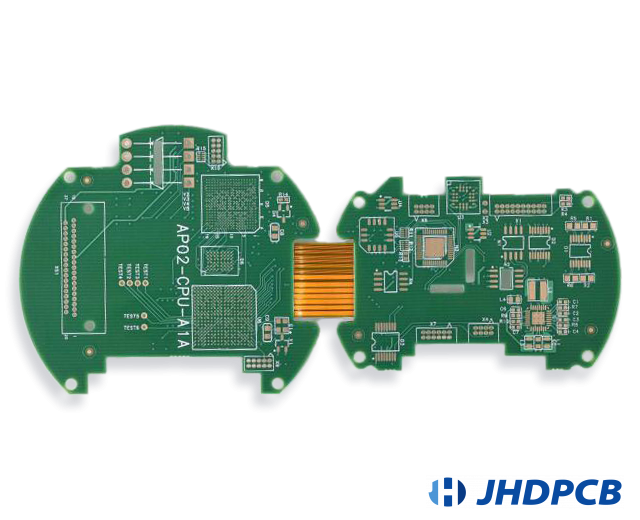
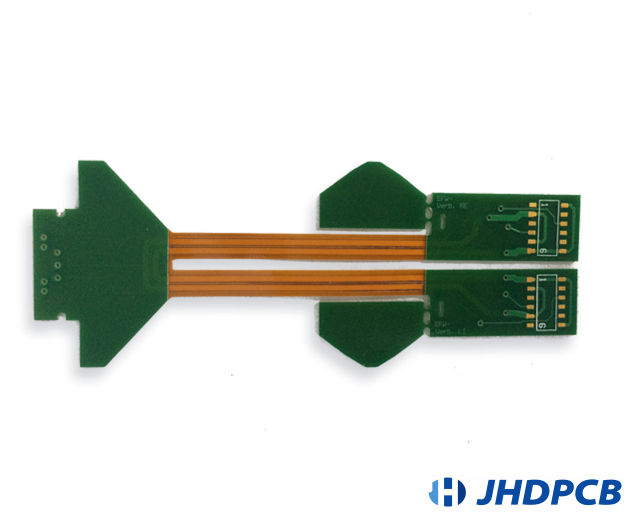
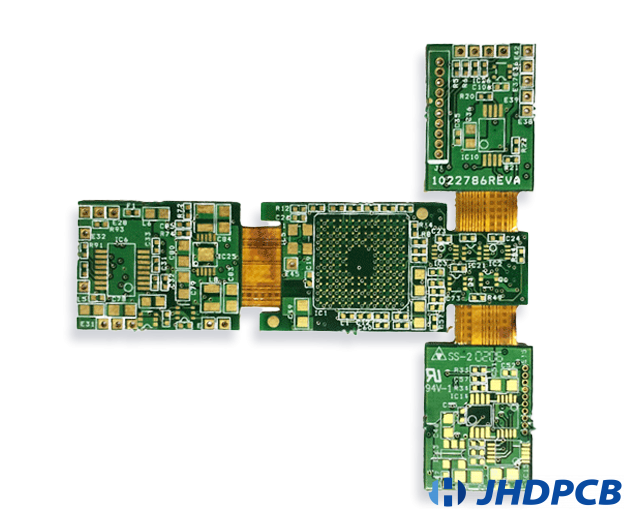


What are the advantages of rigid-flex PCB?
Although the design and manufacturing cost of rigid-flex boards may be higher, they do have many advantages and can solve many problems compare to traditional rigid or flex pcb technology.
1. Flexible shape, minimizing space requirement.
Rigid flex PCB makes it easier to install more components in a smaller space because they can change shape according to specific contours. This technology will reduce the size and weight of the final product as well as the overall system cost. At the same time, the combination of rigid and flexible PCB’s compact shape makes it the best choice for fine-line and high-density circuits in HDI pcb technology.
2. Better space utilization.
Compared with flexible pcb, rigid flexible PCB is easier to handle during assembly. By using of rigid flexible PCB, there will be less solder joints and ensure higher connection reliability. This also simplifies assembly process of the PCB.
3. Can be customized for different applications.
Rigid flex pcb is not limited in packaging geometry and can be customized for applications in many industries such as aerospace, military, medical equipment, and consumer electronics. They can be customized in size and shape to suit the housing design and 3D design, which provides designers with more possibilities to meet different requirements in specific applications.
4. Better performance in hostile environments.
Rigid flex pcbs have high impact resistance and high vibration resistance, so they can work normally in high pressure environments. Rigid-flex PCBs use fewer cables and connectors, which also reduces safety risks and maintenance in future use. At the same time reduce the size of the circuit board and the overall system weight.
5. Better mechanical stability.
The stability of the rigid board and the flexibility of the flexible board form a stable structure of the entire package, while retaining the reliability of the electrical connection and the flexibility required for installation in a small space.
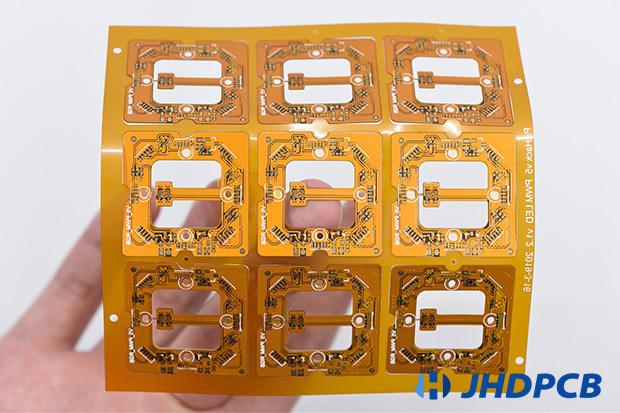
How are Rigid Flex PCBs Made?
Rigid flex pcb fabrication is more complicated than standard rigid PCB or FPC pcb. It is necessary to connect different layers of flexible boards or rigid boards through buried holes or blind holes.
In order to let you understand rigid flex pcb fabrication more intuitively, JHDPCB has made a schematic diagram as follows:
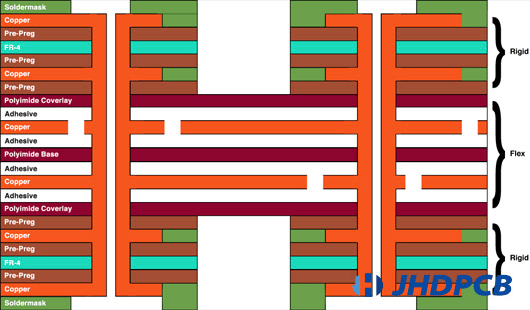
| Feature | Capability |
|---|---|
| Rigid-Flex Thickness | 0.35-4mm |
| Material | Polyimide Flex+FR4 |
| Finish Cooper(Flex Part) | 0.5-2oz |
| Finish Cooper(Rigid Part) | 1-4oz |
| Covrelay (Flex Part) | Yellow Coverlay, WhiteCoverlay, Black Coverlay |
| Solder Mask Color(Rigid Part) | Green, Red, Yellow, Blue, White, Black, Purple, Matte Black, Matte green |
| Track/Spacing | 4mil |
| Hole Size | ≥0.15mm |
| FPC Thickness | 0.08-0.5mm |
| Silkscreen | White, Black (Can Be Customized As Required) |
| Finish Cooper(Rigid Part) | 1-6oz |
| Finish Cooper(Flex Part) | 0.5-2oz |
| Additional Options | Half-Cut,Impedance Control |
| Via | Tenting Vias,Plugged Vias,Vias not covered |
| Lead time | 2-3 Days |
| Build time | 10-20 Days |
As a professional rigid flex pcb manufacturer, JHDPCB using advanced materials can withstand hundreds of thousands of bending cycles without failure. Rigid-flex designs are more adaptable than those in a typical rigid board environment because the boards are designed in 3D space, which also provides greater space efficiency. Flexible substrates can be twisted, folded and rolled to fit the desired shape for electronics applications.
What are the Features of Rigid-flex PCB?
- Rigid-flex PCB can be bent and installed three-dimensionally, effectively use the installation space and reducing the volume of the finished product.
- Rigid-flex PCB has small size and light weight which makes the product in short, small, light and thin.
- Rigid flex PCB has high reliability; the combination of rigid and flexible can replace connectors, ensuring high reliability in harsh environments such as vibration, shock, and humidity.
- Using of rigid-flex pcb Shorten installation time, reduce installation cost, and facilitate operation.
- Rigid flex PCB has the strength of rigid board and can play a supporting role.
Rigid-Flex Design Guidelines:
Rigid-flex designs are very similar to rigid board designs, with the flex layer working as an extension of the rigid area of the board. Similar to a rigid board layout, a rigid-flex fabrication package will include Gerber layers, along with drill files, solder mask, nomenclature, perimeter/routing files, overlays, and more. JHD provides free document checking to avoid large cost waste after production. Note that there are some differences between manufactured packages for rigid-flex PCB and rigid board applications:
Rigid-flex printing usually has flexible dimensional design, except for the “X/Y” axis with an extra “Z” direction, so these boards usually require a 3D application to design. It should also accurately define the rigid-to-flexible transition regions, as these are not always obvious when looking at the Gerber layer alone.
Material layup in a rigid-flex PCB is critical and should be developed in collaboration with your manufacturer. JHDPCB can help you make the right material selection based on your requirements, such as: minimum bend radius required, UL flammability rating, impedance control for flexible and rigid layers, mechanical considerations, lead-free assembly compatibility, RoHS certification, and other considerations.
Rigid-flex boards also require all the additional layers in the Gerber file. The 1st and last layers will have the solder mask and also need to define the overlay and adhesive layer sections of the board (if needed) and the number of artwork layers each going into the rigid board.
What are the Application of Rigid-flex PCB?
Rigid flex pcbs are widely used: wearable smart products, 5G products, semiconductors, digital cameras, tablet computers, mobile phones, modules, navigation, automotive brake system boards, IC carrier boards, T cards, SSDs, graphics cards, solid-state drives, battery boards, WIFI, Camera lens board, industrial control board and many other high-end fields.
In short, rigid-flex PCB combines all the advantages of rigid PCB and flexible PCB, while making up for the defects. JHDPCB has a strict quality control system to ensure that rigid-flex boards are correctly manufactured and assembled with high quality standards. If you need more detailed information, such as a quotation or order, please contact us immediately via sales@jhdpcb.com.





